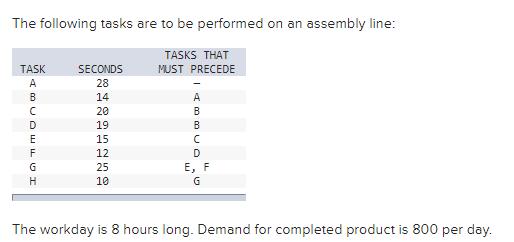Question
a. Find the cycle time required to meet the desired output rate. (Round your answer to 1 decimal place.) b. What is the theoretical number

a. Find the cycle time required to meet the desired output rate. (Round your answer to 1 decimal place.)
b. What is the theoretical number of workstations required to meet the desired output rate? (Round up your answer to the next whole number.)
d. Balance the line using sequential restrictions and the longest-operating-time rule. (Leave no cells blank - be certain to enter "0" wherever required. Round your answers to 1 decimal place.)
| Work station | Task | Idle Time |
|---|---|---|
| I | ||
| II | ||
| III | ||
| IV | ||
| V |
e. What is the efficiency of the line balanced as in part (d) assuming it is running at the cycle time determined in part (a)? (Round your answer to 1 decimal place.)
f. Suppose that demand rose from 800 to 850 units per day. What would you do? (Round your answer for cycle time down to the nearest whole number.)
The following tasks are to be performed on an assembly line: YABCDEFGH TASK SECONDS TASKS THAT MUST PRECEDE 28 14 201 19 15 ABBCD 12 25 10 E, F G The workday is 8 hours long. Demand for completed product is 800 per day.
Step by Step Solution
There are 3 Steps involved in it
Step: 1

Get Instant Access to Expert-Tailored Solutions
See step-by-step solutions with expert insights and AI powered tools for academic success
Step: 2

Step: 3

Ace Your Homework with AI
Get the answers you need in no time with our AI-driven, step-by-step assistance
Get Started


